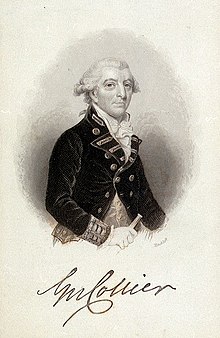In command of that little Royal Navy fleet was Commander Sir George Collier (1738-1795, shown here).
That afternoon, the Rainbow “discovered Three Sail,” Collier reported. He “could form no Judgement of their Force, or what they were,” so he “immediately gave Chace.” After all, he was the navy.
The Victor was lagging three or four miles behind, so Cdr. Collier sent a signal to its captain to make more sail and speed up. As the day ended, the Rainbow’s crew could see they were chasing “large Ships” which looked “bound to some of the Ports of New England”—enemy territory.
Collier wrote, “I followed them with all the Sail I could croud.” At dawn his crew made out three ships plus a sloop “about 5 or 6 Miles distant.” Meanwhile, the Victor had fallen so far behind it was no longer in sight.
At this point Cdr. Collier was convinced he’d spotted the “Part of the Rebel Fleet, which had sailed some Time before from Boston.” Despite being outnumbered, he continued the pursuit.
The Rainbow had indeed found Capt. John Manley’s growing fleet, consisting of his Continental frigate Hancock, U.S.S. Boston under Capt. Hector MacNeill, a captured British privateer named Fox, and a recently seized sloop carrying coal.
The last vessel didn’t last long. Manley ordered it set on fire and cut loose. Then he gave orders for “setting Top Gallant Royals and every Sail that could be useful.”
Collier wrote:
A little after Six we discovered another Sail standing towards the Rebel Ships; she crossed us on the contrary Tack at about Four Miles Distance, and put about when she could fetch their Wakes; from her not making the private Signal to me, I concluded that she was another of the Rebel Frigates, and therefore paid no Regard as to an English Red Ensign she hoisted, and two Guns she fire to Leeward.Ships didn’t have to display their true colors until they actually went into battle. Until then, captains could run up any nation’s flag to bluff another ship into thinking they were friendly or neutral or whatever seemed advantageous. Collier therefore suspected there were four enemy vessels ahead of him, but he kept chasing.
About 10:45 A.M., Collier was surprised to see this new ship and one of the original three exchange fire. He ordered his crew to raise the Union Jack. The match had turned out to be three American ships against two British.
The other Royal Navy frigate was H.M.S. Flora, a 32-gun fifth-rate that had started as the French warship Vestale. Its captain was John Brisbane (1735-1807).
One of the American ships split off from the other two. Brisbane on the Flora “exchanged a Broadside with each.” The Rainbow also fired on one that had fallen behind, seemingly “uncertain which to steer,” but “had not the good Fortune to bring down either a Mast or Sail.”
Cdr. Collier watched “the headmost Rebel Frigate put about,…just out of Gunshot to Windward.” He judged it “a very fine Ship of 34 Guns, with Rebel Colours flying.”
An officer on the Rainbow’s quarterdeck recognized that ship from when he had been a prisoner in Boston. It was the Hancock, and its master was Manley, “the Sea Officer in whom the Congress place great Confidence, and who is the Second in Rank in their Navy.”
Cdr. Collier realized he stood at a decision point. Of the enemy ships, he thought, “one of the three must unavoidably escape, if they thus steered different Courses.” The Flora had apparently picked its target, which turned out to be the prize ship Fox.
Collier decided to “put about and follow the Hancock, which appeared the largest Ship,” as well as the most important—and most dangerous.
TOMORROW: Commanders clash.

No comments:
Post a Comment